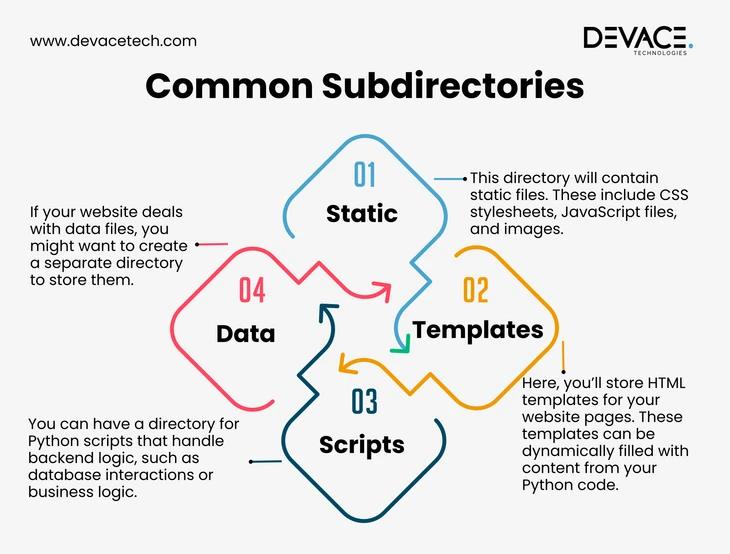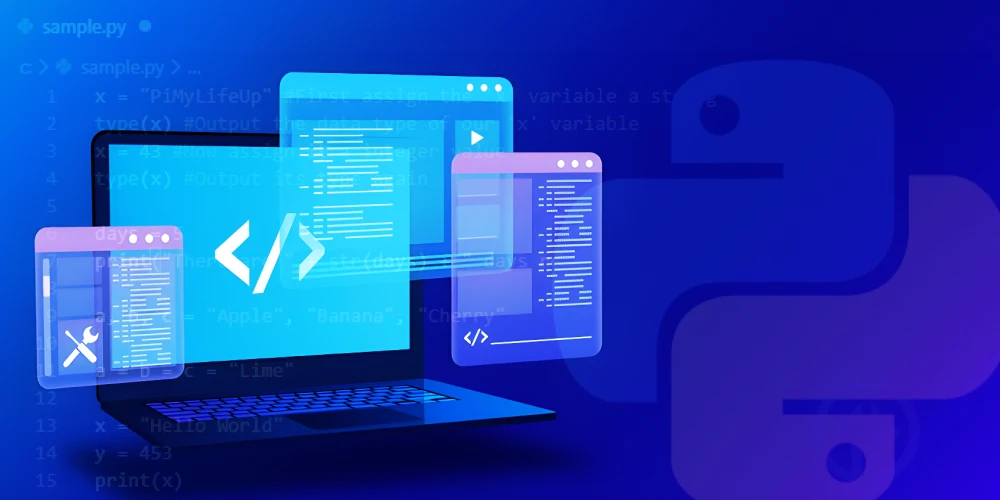Python is one of the top programming languages for creating dynamic and scalable websites. Packed with libraries and top-class frameworks, Python gives you complete control of aesthetics, functions, and functionalities. What more could you ask for?
In this blog, we dig deep into developing websites using Python with step-by-step guidance. Let’s get started.
Make a Website Using Python in 8 Steps
The process to build a website using Python starts from having the understanding and technical knowledge, then design, development, and deployment.

Below is a brief discussion of each of the steps required to build a website with Python.
1. Have an Understanding of Python
Before starting development on Python, you must understand the basic concepts. It will help you to grasp the knowledge and solve little issues or bugs that might occur during development.
Below are the main concepts related to Python for web development:
-
Web Fundamentals
This is one of the most important requirements as it includes client-server architecture. They use the HTTP protocol, web servers, browsers, HTML, CSS, and JavaScript.
Understanding web development fundamentals is important for web styling, structure, and overall creativity.
-
Database Management
Databases are one of the most critical parts of building a Python website as they work for data retrieval.
If you are using Python to create a website, then for data management you must understand DBMS rudimental such as SQLite, PostgreSQL, or MySQL, CRUD operations, relational databases, and SQL for querying.
-
HTML Templating
Templating in creating a website with Python plays an integral role. Therefore, you must learn about the role of web development frameworks like Flask and Django and pass data from Python code to create dynamic HTML content using template engines like Jinja2 and Django’s built-in template language.
-
HTTP Requests and Responses
Another important Python concept for web development is understanding HTTP requests and responses.
You must learn about the complete process of handling HTTP requests and responses in a web application. It also includes learning how to hand various HTTP methods, routing URLs to specific views, and processing form submissions.
2. Choose Your Framework and Databases
Once you have grasped the important concepts, it will get easier for you to start development and get the pace. The next step in how to make a website using Python is choosing one from the best Python frameworks.
There are certain factors that can help in choosing a framework for building Python website such as you should consider the project type, experience level, and lastly framework’s strengths and weaknesses. The two most popular options for building a website with Python are Django and Flask. Let’s discuss them briefly below.
-
Django
It is known for its “batteries-included” approach. In addition to that, it provides built-in tools and features, making it ideal for larger projects or those who need quick project development and deployment. So, if you are looking to develop full-featured applications then Django is the best one.
-
Flask
It is more of a lighter framework that offers flexibility and simplicity.
One thing about Flask is that it is the most suitable framework for smaller projects or minimal websites, especially if you want greater control over components.
It is very crucial to select the right framework as it makes sure that the development process aligns well with your project goals and resources.
-
Pyramid
Another framework that you can use for Python web development id Pyramid.it is known for flexibility and customizations. Moreover, when using Pyramid for building a website with Python, you have a lot of control over how you structure your website.
Other than frameworks, you also have to select the databases so that you can store data easily. It depends on various factors like the type of data and how much the data would need to scale. Below are a few top-listed Python databases.
-
SQL Databases
During the development of Python online applications, developers utilize PostgreSQL, MySQL, and SQLite databases. These types of databases are suitable for the kind of applications that require organized data storage and an advanced level of querying.
-
NoSQL Databases
The next type of database that is used for website development is the NoSQL database. For scalability and flexibility, Python developers use MongoDB, Redis, and Cassandra. They are the most appropriate choice for developing applications with a large amount of unstructured data along with those in which schema may change.
3. Set Up Your Environment
After you have chosen the framework and database, the next is to set up the environment for building the website using Python. Below is a detailed process of how to do it:
- The first step is to install Python on your system. You can download it from their official website (python.org). The recommended version for web development is Python 3.x.
- The next step is to set up the virtual environment to manage the project dependencies. For this, you can use the following code commands to create and activate a virtual environment:
python -m venv venv source venv/bin/activate #On macOS/Linux venv\Scripts\activate #On Windows
- The next step is to install the Python framework based on your project requirements such as Django, Pyramid, or any other one. In this example, we install Flask so let’s take the following code:
pip install flask
- Choose the database for your Python website development such as SQLite, PostgreSQL, or MySQL according to your project requirements. Meanwhile, you will also need to install the database drivers or ORMs (Object Relational Mappers), like SQLAlchemy for Flask or Django ORM for Django.
- If the need is, you might need to install additional libraries for handling things like authentication, requests, or file handling. For example:
pip install requests flask-login
- The last step in setting the environment is configuring the IDE/Editor. For Python web development, you can use Visual Studio Code, PyCharm, or Sublime Text. Install the necessary extensions for Python and web frameworks.
Once your environment is set up, you can start developing, running, and testing your Python web applications.
4. Plan the Website Structure
Planning the website structure is one of the most important steps in how to make a website with Python. During this step, you need to outline the website purpose, target audience, decisions related to main pages and subpages, and finally the UI/UX. In addition to that, you also have to organize directories and files.

Here is how you can do it:
- Set up a main directory for your project.
- Create subdirectories such as Static, Templates, Scripts, or Data within your primary directory to manage your project’s various components.
- Now, create configuration files based on your project requirements.
- After you have created the files, install third-party Python libraries or frameworks within your virtual environment. For this, you can use a package manager like Pip.
- Lastly, start coding for your website by creating HTML templates
- Install third-party libraries or frameworks within your virtual environment using a package manager like pip.
- Start coding by creating HTML templates, defining routes, writing backend logic, and styling your website with your project structure in place.
5. Build the Backend
It is essential to build the backend for strong features and functionality of the website. The backend of the website handles major server-side operations, manages data, and facilitates communication between the server, database, and browsers.
This phase focuses on ensuring that server responses are efficient, that data is stored securely, and that all necessary APIs are integrated for smooth functionality. If this gets a bit technical, the suggestion is to leverage Python development services for quick problem-solving and project growth.
6. Design the Frontend
Other than the backend, front end of a website is significant for a better user experience. In this phase, developers use HTML, CSS, and JavaScript, along with other libraries and frameworks like React, Vue, or Bootstrap, to create an intuitive and visually appealing interface.
Frontend design emphasizes responsive layouts, consistent branding, and accessibility, ensuring the site looks good across devices and remains user-friendly.
7. Connect Database
Now for storing and retrieving data, from user profiles and product information to transaction records, connecting the database is essential. In this step of building Python website, developers integrate databases such as MySQL, MongoDB, or PostgreSQL with the backend.
Developers also have to set up data schemas and optimize database queries to ensure efficient data management and retrieval. Once the database connectivity is properly done, then the application will be able to handle data reliably and scale as needed.
8. Testing & Deployment
Before going live, make sure that you have thoroughly tested the website for its functioning, UI/UX, accessibility, features, and responsiveness. For website testing, it includes various types of testing such as unit, integration, and user acceptance tests, covering functionality, performance, security, and usability.
Once the bugs are identified by a quality assurance engineer and solved by a Python developer, the website is ready for deployment on a web server, using platforms like AWS, Heroku, etc. Post-launch, ongoing monitoring, and maintenance are crucial to ensure the website continues to perform optimally as user demands grow.
Pros and Cons of Python
Python is the leading programming language for developing scalable websites and powering applications in Artificial Intelligence and Machine Learning.
However, it has its pros and cons. Let’s take a brief look at Python pros and cons.
| Pros | Cons |
|---|---|
| Easy to learn with simple syntax, great for beginners. | Slower compared to other languages, and not ideal for high-performance tasks. |
| Extensive libraries for almost any task, from AI to data science. | Can be heavy on memory, which might be an issue for larger projects. |
| Versatile and used in web development, machine learning, and data analysis. | Limited use in mobile app development. |
| Strong community support, with lots of resources available. | Dynamic typing can sometimes lead to unexpected runtime errors. |
| Cross-platform compatibility, code can run on almost any operating system. | Limited with multi-threading due to the Global Interpreter Lock (GIL) bottleneck. |
Before making decisions about using Python for website development, weighing the pros and cons gives a better understanding of what to choose and what not to.
Top Websites That Built on Python
Python is a go-to programming language for its simplicity, readability, and flexibility. Many top websites have used Python, globally. Below are the top websites that are built on Python:
-
Instagram
Instagram relies on Python to manage its massive backend, processing millions of images, videos, and user interactions. Python’s scalability and flexibility have allowed Instagram to grow rapidly while maintaining a smooth user experience, particularly when dealing with the data-heavy nature of social media platforms.
-
Spotify
Python plays a critical role in Spotify’s infrastructure, where it supports backend services, data analysis, and machine learning algorithms that drive personalized music recommendations and playlists. The language’s ability to handle large data sets efficiently makes it an ideal choice for streaming services like Spotify.
-
Dropbox
Dropbox uses Python to manage its cloud storage system, ensuring seamless file synchronization across devices and platforms. The simplicity and readability of Python make it easier for Dropbox’s development team to maintain and scale its service, which is trusted by millions of users to store and share files.
-
YouTube
YouTube’s backend is powered by Python, helping it process and serve millions of videos daily. Python enables YouTube to handle tasks such as video uploading, streaming, and search functionalities. Its ability to scale efficiently supports the vast amount of data that flows through the platform daily.
-
Reddit
Reddit, one of the largest online discussion platforms, is built on Python. The language supports Reddit’s infrastructure by managing user-generated content, ensuring fast page load times, and handling complex data processing. Python’s scalability has allowed Reddit to grow its community while providing a smooth browsing experience.
Bottom Line
Python undoubtedly is a great choice for website development. If you want to achieve a website that runs smoothly, can pull off every brilliant feature and function, and delivers an amazing experience to users – then Python is the best bet. This blog how to make a website with Python gives a complete overview to give you the perfect guidance.
Hire a Python Developer with Devace Technologies
At Devace Technologies, you can hire a Python developer within 48 hours. We provide experienced and skilled developers for web development that match your ideal developer profile and take your project to the next level.
Hire top Python developers today!
Frequently Asked Questions
Is Python suitable for web development?
Yes, Python is the most suitable programming language for web development. It is known for its readability, simplicity, and flexibility which allows seamless integration with third-party services databases, and front-end technologies.
Does Python use a lot of storage?
Python itself is not reliant on too much storage. However, it depends on your project size, scope, features, and functionalities.
If you’re building a large web application with many libraries and dependencies, the storage usage can increase. The best factor about Python is its efficiency in handling databases and files can help manage storage well.
What framework should I choose when using Python website builder?
Python’s two best frameworks are Django and Flask. However, to find a suitable framework for your web development, it depends on your project requirements and what you want from that. Django is great for larger, feature-rich applications, offering built-in features like authentication and admin dashboards. Flask is lighter and more flexible, ideal for smaller applications or when you need full control over the project’s structure.
Can I build a website using Python?
Yes, Python is the top choice for building websites. Whether you need a simple website or a complex one with rich features and functionalities, Python scalability and flexibility will allow you to achieve all.
Can we use Python for front-end web development?
Python is mainly for back-end development. But by using different frameworks like Brython, you can run Python code in the browser, providing limited front-end functionality. For full-fledged front-end development, languages like HTML, CSS, and JavaScript are still the primary tools. Python excels at server-side logic and data management.






